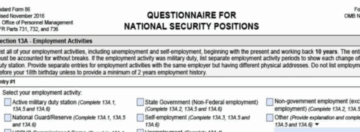Another GAO Report on Clearance Reform
PERSONNEL SECURITY CLEARANCES: An Outcome-Focused Strategy Is Needed to Guide Implementation of the Reformed Clearance Process (GAO-09-488), May 2009:
The security clearance reform process has already been underway for several years, and various agencies involved have created and revised several plans for improvement. Although the high-level leadership and governance structure of the current reform effort distinguish it from previous efforts, without a strategic framework that fully addresses the long-standing security clearance problems and incorporates key practices for transformation including the ability to demonstrate progress leading to desired results the effort is at risk of losing momentum and not being fully implemented.
The GAO report made several recommendations for establishing a strategic framework for the joint reform effort, including clearer goals, outcome-focused performance measures, formal communications strategy, further definition of roles and responsibilities for implementation of IT strategy, and determining funding requirements.
Somewhat disturbing was the Office of Personnel Management’s (OPM) response to the draft version of GAO-09-488:
OPM believes that it is important not to conflate the suitability and security clearance processes. Nonetheless, it recognizes that there are areas of commonality between the two and agrees that both processes should be administered efficiently and aligned where appropriate. The means by which these goals are accomplished, however ”whether through the governance structure established by Executive Order 13467 (and studied by the GAO) or in some other fashion”is currently under review by the new Administration, as are the reform initiatives discussed in the draft report. This review may result in a new governance structure and/or new goals and standards. For that reason, while the critiques discussed in GAO’s report will certainly merit consideration going forward, I do not believe that it would be productive at this time to address with greater specificity the concerns it expresses about the past management of the reform process.
A new governance structure and/or new goals and standards?



Comment Archive
Judging by some of the comments I have read on this blog, My first impression is that the OPM director is going to be taking a look at the upper levels of management in the investigative program. From what I have read and heard 99.9999% of the problems are directly related to the pressure to meet deadlines imposed on contractors and federal staff. You folks who actually do the work know better than I do, Does anyone have any suggestions on how to make the program work better?
I think the current compensation structure for the OPM contractors is the problem. They are compensated by a combination of quality and quantity. The focus (quality vs. quantity) is a pendulum that sways, depending on the political climate. I really think the answer is to give the responsibility back to the feds-get rid of or reduce the OPM contractors and increase the federal workforce. Of course, I may be out of a job if that happens, so maybe that isn’t such a great idea. I have heard (maybe incorrectly?) that the feds don’t have the pressures as the rest of us and that their workloads are not unreasonable. Anyone?
Average Joe,
We do–but not in this forum. I don’t think it’s upper mgt. This process is so big it has formed a life of its own. I believe the ignorance in the process along several lines of govt is the real issue. Sometimes faster is not better!!!!!!!!!!!!
One of the current problems is the number of separate entities conducting investigations. Prior to 1994 two investigative agencies (OFI & DIS) conducted more than 95% of all federal background investigations. Today there are more than 7. Can you imagine 7 different companies, each with its own pipelines, supplying natural gas to the same community?
Back in the 1990’s DIS augmented their federal investigative staff with contractors. Each Field Office SAIC could hire individual contractor investigators. It was a great system to manage office/area caseload. The SAIC or ASAC assigned cases to contract investigators (mostly former federal agents)and reviewed the completed cases. At the time I had 13 federal investigators and 4 contract investigators working for me. A 12 to 5 split would have been better, but a little harder to sustain because we relied on the availability of former federal agents. If a private company had existed to train new contract investigators, I think DIS could have used more of them. Of course money was alway a problem with DIS. My office had enough work for 16 FTE. The contract investigators were fairly well integrated into the office workforce.
Contracting with several companies who must create and maintain their own network of offices and investigators eliminates any potential economy of scale and does little to balance staff and workload from one area to another.
Regarding the new investigative standards, I recently wrote an article on the subject. It is posted at https://news.clearancejobs.com/2009/07/23/new-federal-investigative-standards/
The problem with federal suitability/security background investigations is and has always been money. Everyone wants a quality investigation in the shortest amount of time possible, but no one is willing to pay for it. OPM is only charging about 25% more than it did 10 years ago for an SSBI. That’s an annual increase of less than 2%. Considering the improvement in turnaround time and the rate of inflation over the past 10 years, OPM should be charging 40% to 50% more than it did 10 years ago for an SSBI. Completing an SSBI faster always increases the cost of the investigation, because investigator must work on fewer cases at the same time thus increasing travel time between interview/records checks.